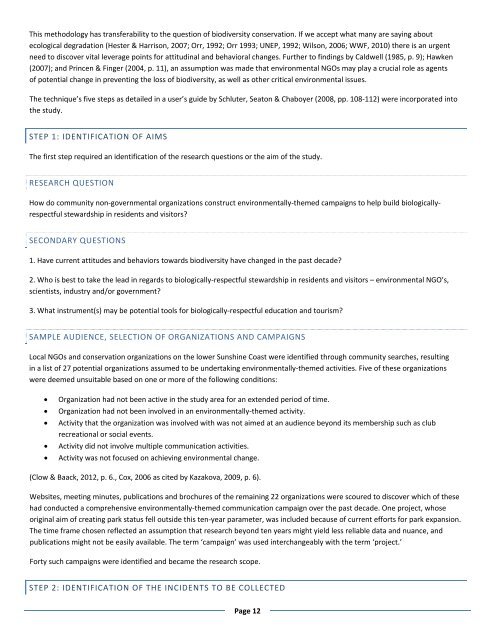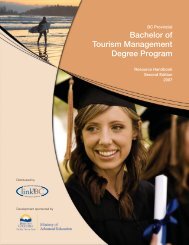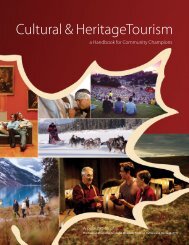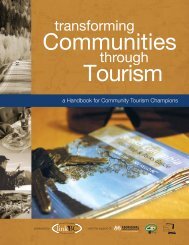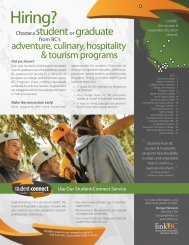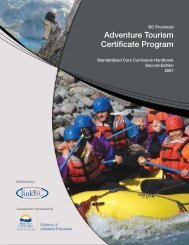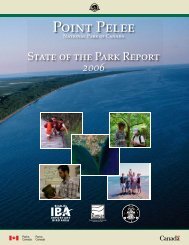Biologically-Respectful Tourism - LinkBC
Biologically-Respectful Tourism - LinkBC
Biologically-Respectful Tourism - LinkBC
You also want an ePaper? Increase the reach of your titles
YUMPU automatically turns print PDFs into web optimized ePapers that Google loves.
This methodology has transferability to the question of biodiversity conservation. If we accept what many are saying about<br />
ecological degradation (Hester & Harrison, 2007; Orr, 1992; Orr 1993; UNEP, 1992; Wilson, 2006; WWF, 2010) there is an urgent<br />
need to discover vital leverage points for attitudinal and behavioral changes. Further to findings by Caldwell (1985, p. 9); Hawken<br />
(2007); and Princen & Finger (2004, p. 11), an assumption was made that environmental NGOs may play a crucial role as agents<br />
of potential change in preventing the loss of biodiversity, as well as other critical environmental issues.<br />
The technique’s five steps as detailed in a user’s guide by Schluter, Seaton & Chaboyer (2008, pp. 108‐112) were incorporated into<br />
the study.<br />
STEP 1: IDENTIFICATION OF AIMS<br />
The first step required an identification of the research questions or the aim of the study.<br />
RESEARCH QUESTION<br />
How do community non‐governmental organizations construct environmentally‐themed campaigns to help build biologicallyrespectful<br />
stewardship in residents and visitors?<br />
SECONDARY QUESTIONS<br />
1. Have current attitudes and behaviors towards biodiversity have changed in the past decade?<br />
2. Who is best to take the lead in regards to biologically‐respectful stewardship in residents and visitors – environmental NGO’s,<br />
scientists, industry and/or government?<br />
3. What instrument(s) may be potential tools for biologically‐respectful education and tourism?<br />
SAMPLE AUDIENCE, SELECTION OF ORGANIZATIONS AND CAMPAIGNS<br />
Local NGOs and conservation organizations on the lower Sunshine Coast were identified through community searches, resulting<br />
in a list of 27 potential organizations assumed to be undertaking environmentally‐themed activities. Five of these organizations<br />
were deemed unsuitable based on one or more of the following conditions:<br />
• Organization had not been active in the study area for an extended period of time.<br />
• Organization had not been involved in an environmentally‐themed activity.<br />
• Activity that the organization was involved with was not aimed at an audience beyond its membership such as club<br />
recreational or social events.<br />
• Activity did not involve multiple communication activities.<br />
• Activity was not focused on achieving environmental change.<br />
(Clow & Baack, 2012, p. 6., Cox, 2006 as cited by Kazakova, 2009, p. 6).<br />
Websites, meeting minutes, publications and brochures of the remaining 22 organizations were scoured to discover which of these<br />
had conducted a comprehensive environmentally‐themed communication campaign over the past decade. One project, whose<br />
original aim of creating park status fell outside this ten‐year parameter, was included because of current efforts for park expansion.<br />
The time frame chosen reflected an assumption that research beyond ten years might yield less reliable data and nuance, and<br />
publications might not be easily available. The term ‘campaign’ was used interchangeably with the term ‘project.’<br />
Forty such campaigns were identified and became the research scope.<br />
STEP 2: IDENTIFICATION OF THE INCIDENTS TO BE COLLECTED<br />
Page 12


